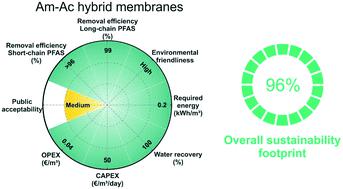当前位置:
X-MOL 学术
›
Environ. Sci.: Water Res. Technol.
›
论文详情
Our official English website, www.x-mol.net, welcomes your
feedback! (Note: you will need to create a separate account there.)
Amyloid fibril-based membranes for PFAS removal from water
Environmental Science: Water Research & Technology ( IF 3.5 ) Pub Date : 2021-08-16 , DOI: 10.1039/d1ew00373a Tonghui Jin 1 , Mohammad Peydayesh 1 , Hanna Joerss 2, 3 , Jiangtao Zhou 1 , Sreenath Bolisetty 4 , Raffaele Mezzenga 1, 5
Environmental Science: Water Research & Technology ( IF 3.5 ) Pub Date : 2021-08-16 , DOI: 10.1039/d1ew00373a Tonghui Jin 1 , Mohammad Peydayesh 1 , Hanna Joerss 2, 3 , Jiangtao Zhou 1 , Sreenath Bolisetty 4 , Raffaele Mezzenga 1, 5
Affiliation

|
We introduce a green and efficient approach for removing per- and polyfluoroalkyl substances (PFASs) based on the β-lactoglobulin amyloid fibril membrane. The membrane exhibits superior adsorption capability for long-chain PFASs. At low pH, the membrane efficiency improved significantly due to enhanced electrostatic interactions between positively charged fibrils and negatively charged PFASs. Furthermore, intermolecular adhesion force measurements confirm the hydrophobic–hydrophobic interaction at the nanoscale with PFOS and PFOA representing perfluoroalkyl sulfonic acids (PFSAs) and perfluoroalkyl carboxylic acids (PFCAs), respectively. For real PFAS-contaminated water from the Xiaoqing River basin and under single-step filtration mode, the membrane exhibits high efficiency for removing both high (>μg L−1) and trace (ng L−1) levels of the compounds. To demonstrate the scalability and generality, a commercial amyloid–carbon-based hybrid membrane is applied for removal of a range of long-chain and short-chain PFASs as well as their replacement compounds, offering complete removal of PFASs with ≥4 perfluorinated carbon atoms in the molecular structure and a removal efficiency of low molecular weight PFBA (3 perfluorinated carbon atoms) exceeding 96%. Analysis of the sustainability footprint reveals the superiority of the amyloid–carbon hybrid membrane for PFAS removal. Altogether, these results demonstrate a high potential of amyloid fibril membrane technology for the sustainable removal of PFASs from water.
中文翻译:

用于从水中去除 PFAS 的基于淀粉样原纤维的膜
我们介绍了一种基于 β-乳球蛋白淀粉样蛋白原纤维膜去除全氟和多氟烷基物质 (PFAS) 的绿色有效方法。该膜对长链 PFAS 具有优异的吸附能力。在低 pH 值下,由于带正电的原纤维和带负电的 PFAS 之间的静电相互作用增强,膜效率显着提高。此外,分子间粘附力测量证实了纳米级的疏水-疏水相互作用,PFOS 和 PFOA 分别代表全氟烷基磺酸 (PFSA) 和全氟烷基羧酸 (PFCA)。对于来自小清河流域的真实 PFAS 污染水,在单步过滤模式下,该膜表现出高效去除高 (>μg L -1) 和痕量 (ng L -1 ) 水平的化合物。为了证明可扩展性和通用性,一种商业淀粉样碳基杂化膜被用于去除一系列长链和短链 PFAS 及其替代化合物,从而完全去除含≥4 个全氟碳原子的 PFAS分子结构和低分子量 PFBA(3 个全氟碳原子)的去除效率超过 96%。对可持续性足迹的分析揭示了淀粉样碳杂化膜在去除 PFAS 方面的优越性。总之,这些结果证明了淀粉样原纤维膜技术在可持续去除水中全氟和多氟烷基物质方面的巨大潜力。
更新日期:2021-09-01
中文翻译:

用于从水中去除 PFAS 的基于淀粉样原纤维的膜
我们介绍了一种基于 β-乳球蛋白淀粉样蛋白原纤维膜去除全氟和多氟烷基物质 (PFAS) 的绿色有效方法。该膜对长链 PFAS 具有优异的吸附能力。在低 pH 值下,由于带正电的原纤维和带负电的 PFAS 之间的静电相互作用增强,膜效率显着提高。此外,分子间粘附力测量证实了纳米级的疏水-疏水相互作用,PFOS 和 PFOA 分别代表全氟烷基磺酸 (PFSA) 和全氟烷基羧酸 (PFCA)。对于来自小清河流域的真实 PFAS 污染水,在单步过滤模式下,该膜表现出高效去除高 (>μg L -1) 和痕量 (ng L -1 ) 水平的化合物。为了证明可扩展性和通用性,一种商业淀粉样碳基杂化膜被用于去除一系列长链和短链 PFAS 及其替代化合物,从而完全去除含≥4 个全氟碳原子的 PFAS分子结构和低分子量 PFBA(3 个全氟碳原子)的去除效率超过 96%。对可持续性足迹的分析揭示了淀粉样碳杂化膜在去除 PFAS 方面的优越性。总之,这些结果证明了淀粉样原纤维膜技术在可持续去除水中全氟和多氟烷基物质方面的巨大潜力。











































 京公网安备 11010802027423号
京公网安备 11010802027423号